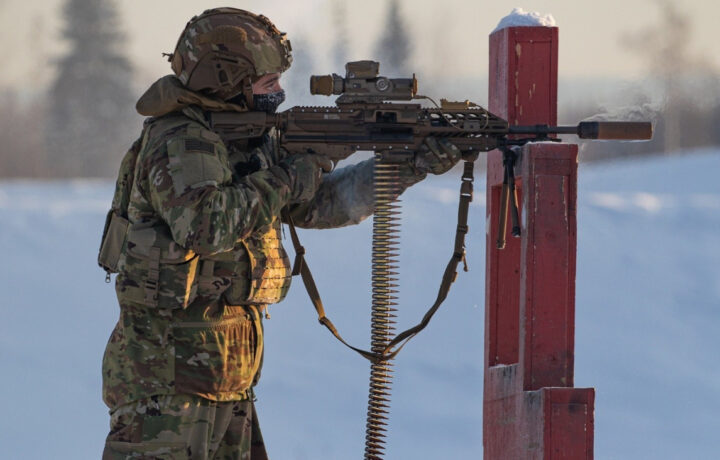The United States Army trains its soldiers to deal with extreme cold and heat – and has developed specialty gear to deal with those extremes. However, while uniforms and equipment may be tailored to the environment, soldiers generally carry the same weapons.
That is why the service conducted a multi-week test of its Next Generation Squad Weapon (NGSW) at the U.S. Army Cold Regions Test Center (CRTC) at Fort Greely, AK earlier this year. Soldiers from the U.S. Army’s 11th Airborne stationed at Alaska’s Joint Base Elmendorf-Richardson supported the testing.
The soldiers and testers employed the weapons in a variety of rigorous scenarios, from static and kinetic ranges at Fort Greely and Fort Wainwright to maneuver live fires and ultimately a 72-hour simulated mission across CRTC’s vast ranges. During the testing, a team of 16 data collectors recorded information in the weapons’ battery life, hit-miss data on targets the soldiers engaged, and a variety of human factors data involving utilizing the weapons in extreme cold.
“We knew it was going to be extremely fast-paced and that usually means there will be changes,” said Monica Gaschler, senior data collector. “We settled on 16 data collectors, which meant one data collector per three soldiers. 14 went out in the field, and two stayed in house to do quality assurance on the data and write test incident reports.”
Out With the Old – In With the New
It was two years ago that the United States Army announced that it had selected Sig Sauer to produce the NGSW that will eventually replace the legacy M4 carbine and M249 light machine gun. It followed a rigorous 27-month prototyping and evaluation period, after which the U.S. Army awarded the Virginia-based Sig Sauer, Inc. a 10-year firm-fixed price follow-on production contract to manufacture and deliver two NGSW variants.
Sig Sauer’s XM7 and XM250 are successors to the M4 rifle and M249 light machine gun that American forces have used for decades. The new weapons boast improved accuracy and range, weigh less, and fire with less recoil even though their 6.8-millimeter round is larger than the two legacy weapons’ 5.56 mm cartridge.
“The big idea behind this weapon is for close-combat forces,” explained Steven Prewitt, test officer. “It’s a capability gap-filler for infantry and special forces, not necessarily an M4 replacement. It gives them a different tool.”
The U.S. Army had sought to replace the legacy small arms with a new weapon that could serve as both the main battle rifle and squad automatic weapon – both chambered in the newly developed 6.8x43mm Remington Special Purpose Cartridge (6.8 SPC).
101st Airborne Became The First to Field the NGSW
Just last month, soldiers from the U.S. Army’s 101st Airborne Division “Screaming Eagles” at Fort Campbell, KY, became the first unit equipped with the NGSW.
Soldiers with the 1st Battalion, 506th Infantry Regiment accepted the NGSW in preparation for an equipment trainer course this month. This follows troops of Alpha Company, 2nd Battalion, 502nd Infantry Regiment, 2nd Brigade, 101st Airborne Division (Air Assault) and members of 1st Battalion, 75th Ranger Regiment, who each undertook New Equipment Training on the NGSW last December.
The training covered the similarities and differences between the new weapons and the legacy 5.56mm M4A1 Carbine and M249 Squad Automatic Weapon systems, focusing on enhanced lethality.
“The process of developing and fielding new equipment is never without challenges and setbacks and speed bumps, so we’re celebrating the fact that we’re delivering on schedule, as promised,” Lt. Col. Mark Vidotto, from the Army’s Soldier Lethality Cross Functional Team at Fort Moore, Georgia, said in a statement. “It was a team effort from start to finish.”
The U.S. Army also recently awarded a contract to Olin Winchester, the operating contractor of Lake City Army Ammunition Plant, to construct a facility to manufacture ammunition for the weapons. Partners included JPEO Armaments and Ammunition, Sig Sauer and optics maker Vortex.




